Newbie gardeners are greeted to the gardening book section by thick encyclopedias on Crocus, for example, or how to design in specific styles. But when I was a new gardener, I didn’t know what style I wanted to design in. And I was still working my way through the common, easy-to-grow plants – I think that deep passions for one particular type of plant come when we’re exhausted of seeing the same old things on every trip to the nursery.
So what books should a newbie gardener look for? Here are my top suggestions – books that walk you through the processes involved in gardening, while having enough depth so that you won’t grow out of them in time.
From the Ground Up: The Story of a First Garden by Amy Stewart
by Amy Stewart
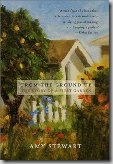 This is easily the sweetest book about gardening that I’ve read. Amy walks us through her experiences as a new gardener, and manages to capture the transcendent and the dirty with clarity and warmth. I first read it as a seasoned gardener, and it brought me right back to my first few years of gardening – the mistakes we all make, the new joys we discover, and the sense of wonder inherent in helping plants to thrive. You’ll love it, and you’ll want to buy copies for your new gardening friends.
This is easily the sweetest book about gardening that I’ve read. Amy walks us through her experiences as a new gardener, and manages to capture the transcendent and the dirty with clarity and warmth. I first read it as a seasoned gardener, and it brought me right back to my first few years of gardening – the mistakes we all make, the new joys we discover, and the sense of wonder inherent in helping plants to thrive. You’ll love it, and you’ll want to buy copies for your new gardening friends.
The Well-Tended Perennial Garden: Planting and Pruning Techniques by Traci Disabato-Aust
by Traci Disabato-Aust
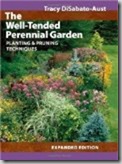 While this book contains a very helpful plant-by-plant reference section, the best part of this book is the first half, where Traci draws on her years of gardening experience to share the nuances of how plants grow and respond to pruning. Even as a landscape maintenance professional, I go back and re-read this classic every few years to solidify my knowledge of how to care for and prune perennials. Her language is clear and fun to read, even for beginners.
While this book contains a very helpful plant-by-plant reference section, the best part of this book is the first half, where Traci draws on her years of gardening experience to share the nuances of how plants grow and respond to pruning. Even as a landscape maintenance professional, I go back and re-read this classic every few years to solidify my knowledge of how to care for and prune perennials. Her language is clear and fun to read, even for beginners.
Pruning and Training by Brickell and Joyce (runner-up: The Pruning of Trees, Shrubs and Conifers by Brown and Kirkham)
by Brown and Kirkham)
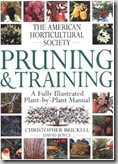 Pruning and Training is the hands-down clearest reference on pruning everything with woody stems – berries, shrubs, roses, as well as both ornamental and fruit trees. The entire book is full-color, so every page has photos and colored illustrations that make it easy to understand how to prune.
Pruning and Training is the hands-down clearest reference on pruning everything with woody stems – berries, shrubs, roses, as well as both ornamental and fruit trees. The entire book is full-color, so every page has photos and colored illustrations that make it easy to understand how to prune.
There are generalized sections on how to make pruning cuts or prune for different styles, but the majority of the book is split into reference sections, where you can look up the name of your plant and get very straightforward advice on how to train it when it’s young, prune it when mature, and renovate anything that has been neglected.
The Pruning of Trees, Shrubs, and Conifers provides a deeper understanding of pruning concepts, but has few pictures and diagrams, so it’s less appropriate for beginners. Still, if you find yourself reading Pruning and Training and going, “but WHY do I do that?”, then you should definitely pick up The Pruning of Trees, Shrubs and Conifers.
The Informed Gardener and The Informed Gardener Blooms Again by Linda Chalker-Scott
by Linda Chalker-Scott
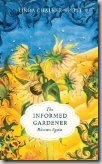 Linda is a sensible, down-to-earth guide to gardening practices, and these books of essays discuss and debunk all kinds of gardening myths, and try to get at the truth behind our assumptions when gardening.
Linda is a sensible, down-to-earth guide to gardening practices, and these books of essays discuss and debunk all kinds of gardening myths, and try to get at the truth behind our assumptions when gardening.
She takes a scientific perspective and discusses agricultural and other studies to find evidence for and against different ways of gardening. The one pitfall she falls into is that she will sometimes claim that something isn’t a great idea because there is no scientific evidence to prove that it works. However, in some cases, there is no evidence because no relevant studies have been completed, so it’s actually premature to make a strong decision on those practices.
As long as you take a scientific approach to reading (question everything, do your own homework, and accept that new evidence may lead you in other directions with time and more study), these books are a fantastic springboard to use in examining gardening practices and establishing your own ways of doing things. I found it so much fun to analyze the evidence and really think about why we do what we do in the garden, and Linda’s common-sense style is a pleasure to read.
What’s Wrong With My Plant? (And How Do I Fix It?) by Deardorff and Wadsworth
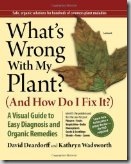 Easily the most valuable pest control and plant health book I own, this handbook walks you through all kinds of problems that you can have with plants, from spotted leaves, different kinds of pest damage, nutrient deficiencies and more.
Easily the most valuable pest control and plant health book I own, this handbook walks you through all kinds of problems that you can have with plants, from spotted leaves, different kinds of pest damage, nutrient deficiencies and more.
It’s like the choose-your-own-adventure of plant handbooks. You start out by selecting the broadest category of what can be wrong with a plant and proceed to narrow down what could be wrong with your plant based on colored drawings that are extremely easy to understand. The authors take an organic approach and discuss which types of sprays or controls are useful, and in what conditions they are safest and most effective.
Want to see more garden blogger book favorites? Check out the Five Books for Gardeners lists to read more.
2 responses to “Five Books: for Beginning Gardeners”
Gen, That’s a great list of books. I have many of them in my own library. I also like ‘What’s Wrong with My Plant’ but must admit it was a bit overwhleming at first and I had to spend some time with it before the format really clicked in. I would add another book to the list for newbies – Dirr’s Hardy Trees and Shrubs. I like that it’s so comprehensive, has photos, no nonsense info and lots and lots of lists of plants to use with different site conditions. When I was first starting out with gardening I remember being afraid to buy trees because they were expensive and I didn’t want to make the wrong decision.
Debbie, what an excellent addition! I too love Dirr, though I think it might be even better for you east-coasters than it is for us (and it’s a pretty good book for us!). The thing I wish they’d do is update it with more appealing photos. I find if a show a client a photo in the Dirr book, they invariably can’t see the charm that they do if I show them the plant at the nursery. I think his text is perfect, but the pictures, while accurate, don’t do the plants many favors.
You are so right about What’s Wrong with my Plant needing some time to get used to. I took it into the bath and sat with it an hour, and came out wrinkled and raving about it. 🙂